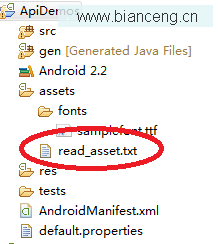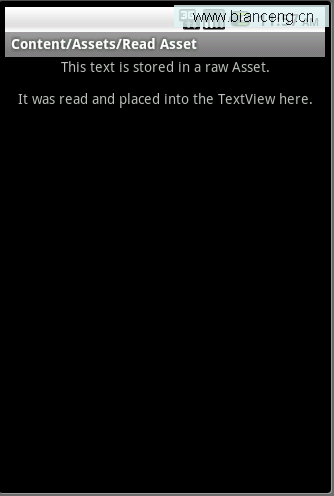編輯:Android開發教程
android.Content包定義了一些類,這些類主要用於在設備上訪問或是發布數據,主要有三個包構成。
Content 共享 (android.content) 主要用於在Application的各個部件自己共享一些數據,主要的列有Content Provider,ContentResolver用於管理和發布數據。 Intent,IntentFilter 用於Application不同組件之間發送消息。
Package 管理 (android.content.pm) 用於訪問Android Package (.apk)定義的Activities, Permissions, Services, Signatures和Providers,主要的類為PackageManager。
資源管理 (android.content.res) 用於訪問應用中定義的資源,如Strings,Drawables, Media,Device Configuration等 等,主要的類為Resources。
一般來說Application把資源放在res目錄下面,有些情況下Application需要使用一些自定義的文件,一種方法是將它們放在 res/raw 目錄下面,另外一種方法是將它們放在assets目錄下,和res 目錄不同的是,Android SDK不會為目錄assets 下的文件 生成資源ID,而是通過AssetManager 以文件的文件名來訪問,放在/assets的目錄機構是什麼樣的,使用AssetManager 訪問時 也是采用同樣的文件結構。和res相比,assets 提供了更低一層次的資源訪問。
本例使用AssetManager來訪問assets 目 錄下的read_asset.txt 。

InputStream is = getAssets().open("read_asset.txt");
// We guarantee that the available method returns the total
// size of the asset... of course, this does mean that a single
// asset can't be more than 2 gigs.
int size = is.available();
// Read the entire asset into a local byte buffer.
byte[] buffer = new byte[size];
is.read(buffer);
is.close();
// Convert the buffer into a string.
String text = new String(buffer);
// Finally stick the string into the text view.
TextView tv = (TextView)findViewById(R.id.text);
tv.setText(text);
在Activity 中可以通過getAssets() 來取得AssetManager對象,和文件操作類似AssetManager可 以通過字節流的方式來讀取文件。

 android技巧:android應用R文件無法讀取的問題
android技巧:android應用R文件無法讀取的問題
很多時候當我們發現從網上下載的一些工程無法使用,只有R布局文件報錯的時候,多數原因是工程本身的target和自身eclipse的target不符合。而自己的target可
 詳解Cocos2dx 3.0正式版本開發環境搭建(Win32/Android)
詳解Cocos2dx 3.0正式版本開發環境搭建(Win32/Android)
cocos2d-x 3.0發布有一段時間了,作為一個初學者,我一直覺得cocos2d-x很坑。每個比較大的版本變動,都會有不一樣的項目創建方式,每次的跨度都挺大&hell
 Android開發環境配置完成
Android開發環境配置完成
最近對Google開發的開源智能手機操作系統Android比較感興趣,因此根據網上的資料下載了Eclipse,Android SDK3.0,並根據提示的步驟進行了環境的配
 Android開發入門(十九)數據庫 19.3 預創建數據庫
Android開發入門(十九)數據庫 19.3 預創建數據庫
在開發過程中,有時候,預先創建好數據庫比在程序運行時創建數據庫更加地高效。舉個例子,你想編寫 一個程序,這個程序把你去過的地方的坐標都顯示出來。這種情況下,預先創建數據庫